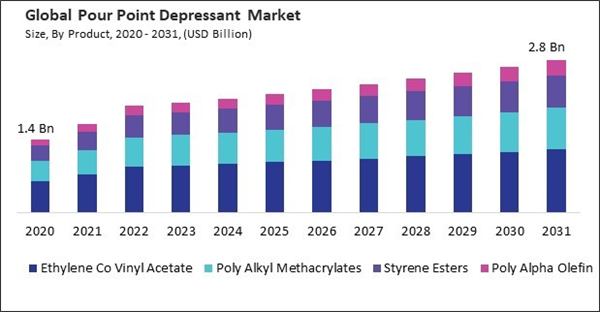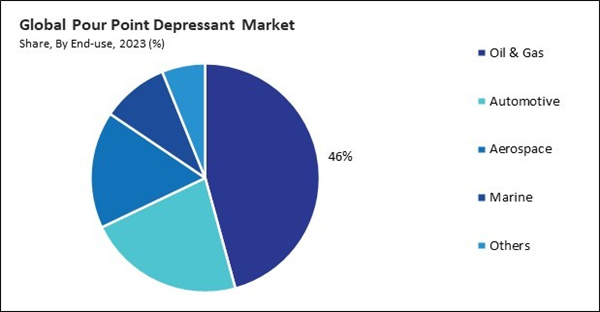The Global Pour Point Depressant Market size is expected to reach $2.8 billion by 2031, rising at a market growth of 4.3% CAGR during the forecast period. In the year 2023, the market attained a volume of 7,983.68 hundred tonnes experiencing a growth of 19.1% (2020-2023).
Styrene esters are compatible with various petroleum systems, including gasoline, diesel, heating oil, and lubricants. They can be easily blended with base oils and other additives to formulate these depressants with tailored performance characteristics and enhanced stability. Consequently, the styrene esters segment would acquire nearly, 21% of the total market share by 2031. Also, Russia would consume 116.44 hundred tonnes of Styrene esters by 2031. Their compatibility with petroleum fluids minimizes the risk of phase separation, precipitation, and degradation, making them ideal additives for various applications in the petroleum industry.
The primary impact of increasing demand for petroleum products is the overall growth of the market. As the demand for petroleum products such as gasoline, diesel, and lubricants rises, there is a parallel increase in the need for these depressants to ensure efficient transportation, storage, and usage, particularly in regions with colder climates. Hence, increasing demand for petroleum products is propelling the market's growth. Additionally, Cold climates, such as those in Arctic regions or northern latitudes, present unique challenges for exploration and production of oil and gas. As demand for petroleum products continues to rise globally, particularly for heating fuels, transportation fuels, and lubricants, there is a corresponding increase in exploration and production (E&P) activities. These activities are aimed at tapping into new reserves and meeting growing energy needs, particularly in cold climates. These depressants play a crucial role in ensuring the efficient production, transportation, and utilization of petroleum products in cold weather conditions, thereby supporting the expansion of E&P activities. Thus, growing E&P activities in cold climates is promoting the growth of the market.
However, Variations in crude oil prices can result in unpredictability regarding the demand for petroleum products. When oil prices are high, there may be a slowdown in economic activity and a reduction in energy consumption, leading to lower demand for petroleum products such as diesel, gasoline, and lubricants. Moreover, volatility in crude oil prices affects investment decisions in oil and gas exploration and production projects. Therefore, volatility in crude oil prices is hampering the market's growth.
Styrene esters are compatible with various petroleum systems, including gasoline, diesel, heating oil, and lubricants. They can be easily blended with base oils and other additives to formulate these depressants with tailored performance characteristics and enhanced stability. Consequently, the styrene esters segment would acquire nearly, 21% of the total market share by 2031. Also, Russia would consume 116.44 hundred tonnes of Styrene esters by 2031. Their compatibility with petroleum fluids minimizes the risk of phase separation, precipitation, and degradation, making them ideal additives for various applications in the petroleum industry.
The primary impact of increasing demand for petroleum products is the overall growth of the market. As the demand for petroleum products such as gasoline, diesel, and lubricants rises, there is a parallel increase in the need for these depressants to ensure efficient transportation, storage, and usage, particularly in regions with colder climates. Hence, increasing demand for petroleum products is propelling the market's growth. Additionally, Cold climates, such as those in Arctic regions or northern latitudes, present unique challenges for exploration and production of oil and gas. As demand for petroleum products continues to rise globally, particularly for heating fuels, transportation fuels, and lubricants, there is a corresponding increase in exploration and production (E&P) activities. These activities are aimed at tapping into new reserves and meeting growing energy needs, particularly in cold climates. These depressants play a crucial role in ensuring the efficient production, transportation, and utilization of petroleum products in cold weather conditions, thereby supporting the expansion of E&P activities. Thus, growing E&P activities in cold climates is promoting the growth of the market.
However, Variations in crude oil prices can result in unpredictability regarding the demand for petroleum products. When oil prices are high, there may be a slowdown in economic activity and a reduction in energy consumption, leading to lower demand for petroleum products such as diesel, gasoline, and lubricants. Moreover, volatility in crude oil prices affects investment decisions in oil and gas exploration and production projects. Therefore, volatility in crude oil prices is hampering the market's growth.
End-Use Analysis
On the basis of end-use, the market is segmented into oil & gas, automotive, aerospace, marine, and others. In 2023, the aerospace segment attained a 16.5% revenue share in the market. In terms of volume, the aerospace segment registered 1,280.18 hundred tonnes in 2023. Safety is paramount in the aerospace industry, and any disruption to fuel flow due to wax buildup can jeopardize flight operations. These depressants are essential for maintaining the dependability and safety of aircraft because they stop fuel filter clogs, fuel line icing, and engine flameouts brought on by disruptions in fuel flow.Product Analysis
Based on product, the market is divided into poly alkyl methacrylates, ethylene co vinyl acetate, styrene esters, and poly alpha olefin. The poly alkyl methacrylates segment attained a 27% revenue share in the market in 2023. In terms of volume, the poly alkyl methacrylates segment registered 1,633.28 hundred tonnes in 2023. Poly alkyl methacrylates (PAMAs) exhibit enhanced thermal stability, allowing them to maintain effectiveness over a wide temperature range. Their resistance to thermal degradation ensures consistent depressant performance, even under extreme operating conditions encountered in the petroleum industry.Regional Analysis
Region-wise, the market is analyzed across North America, Europe, Asia Pacific, and LAMEA. The Asia Pacific region witnessed 38% revenue share in the market in 2023. The Asia Pacific region is home to rapidly growing economies such as China, India, and Southeast Asia, where industrial activities and energy consumption are rising. Industrial sectors such as manufacturing, construction, and transportation rely heavily on petroleum products for fuel, lubricants, and raw materials. As industrialization progresses, the demand for these depressants to ensure the smooth flow of petroleum products in industrial processes increases accordingly.List of Key Companies Profiled
- Clariant AG
- Lubrizol Corporation (Berkshire Hathaway, Inc.)
- Evonik Industries AG (RAG-Stiftung)
- Ecolab, Inc
- Sanyo Chemical Industries, Ltd
- Infineum International Limited.
- Shenyang Great Wall Lubricant Manufacturing Co., Ltd
- Puyang Jiahua Chemical Co., Ltd
- Innospec Inc
- Akzo Nobel N.V.
Market Report Segmentation
By Product (Volume, Hundred Tonnes, USD Billion, 2020-31)- Ethylene Co Vinyl Acetate
- Poly Alkyl Methacrylates
- Styrene Esters
- Poly Alpha Olefin
- Oil & Gas
- Automotive
- Aerospace
- Marine
- Others
- North America
- US
- Canada
- Mexico
- Rest of North America
- Europe
- Germany
- UK
- France
- Russia
- Spain
- Italy
- Rest of Europe
- Asia Pacific
- China
- Japan
- India
- South Korea
- Singapore
- Malaysia
- Rest of Asia Pacific
- LAMEA
- Brazil
- Argentina
- UAE
- Saudi Arabia
- South Africa
- Nigeria
- Rest of LAMEA
Table of Contents
Chapter 1. Market Scope & Methodology
Chapter 2. Market at a Glance
Chapter 3. Market Overview
Chapter 4. Global Pour Point Depressant Market by Product
Chapter 5. Global Pour Point Depressant Market by End-use
Chapter 6. Global Pour Point Depressant Market by Region
Chapter 7. Company Profiles
Companies Mentioned
- Clariant AG
- Lubrizol Corporation (Berkshire Hathaway, Inc.)
- Evonik Industries AG (RAG-Stiftung)
- Ecolab, Inc
- Sanyo Chemical Industries, Ltd
- Infineum International Limited.
- Shenyang Great Wall Lubricant Manufacturing Co., Ltd
- Puyang Jiahua Chemical Co., Ltd
- Innospec Inc
- Akzo Nobel N.V.
Methodology

LOADING...










